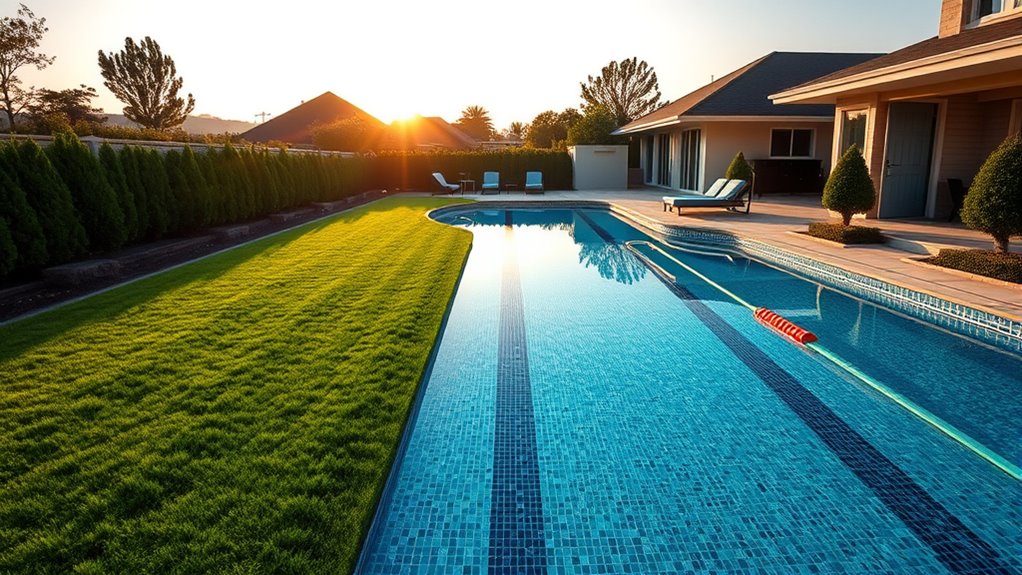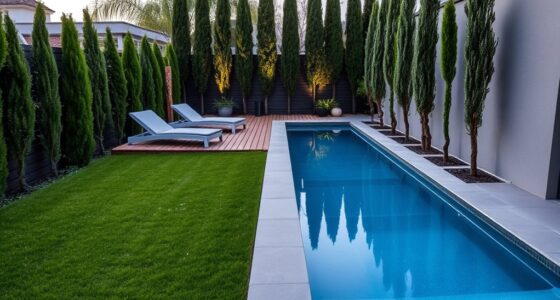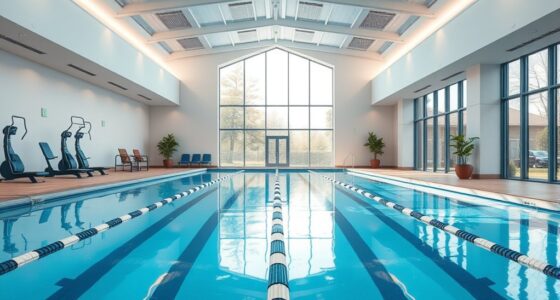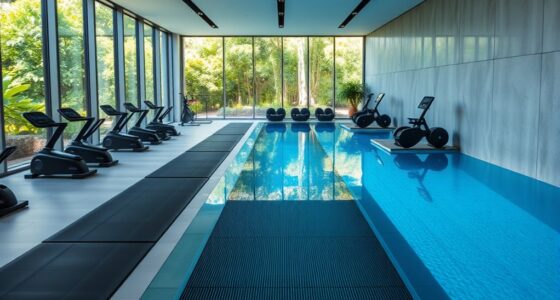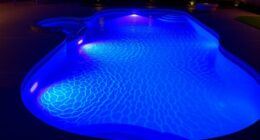Building a lap lane in your yard typically costs between $10,000 and $25,000, depending on factors like size, materials, and site conditions. Excavation, shell construction, plumbing, and finish choices all influence the overall price. If your yard is uneven or has challenging soil, costs could rise. Proper planning and comparing contractor quotes can help control expenses. Keep exploring to discover more tips on designing and constructing your perfect lap lane.
Key Takeaways
- The size and length of the lap lane directly influence construction costs and excavation requirements.
- Soil condition and yard terrain affect labor, material costs, and overall project complexity.
- Finish options like tile or plaster impact budget and long-term maintenance expenses.
- Permits and regulatory compliance may add to costs, especially for in-ground modifications.
- Additional features, such as smart systems or lane lighting, can increase overall project expenses.
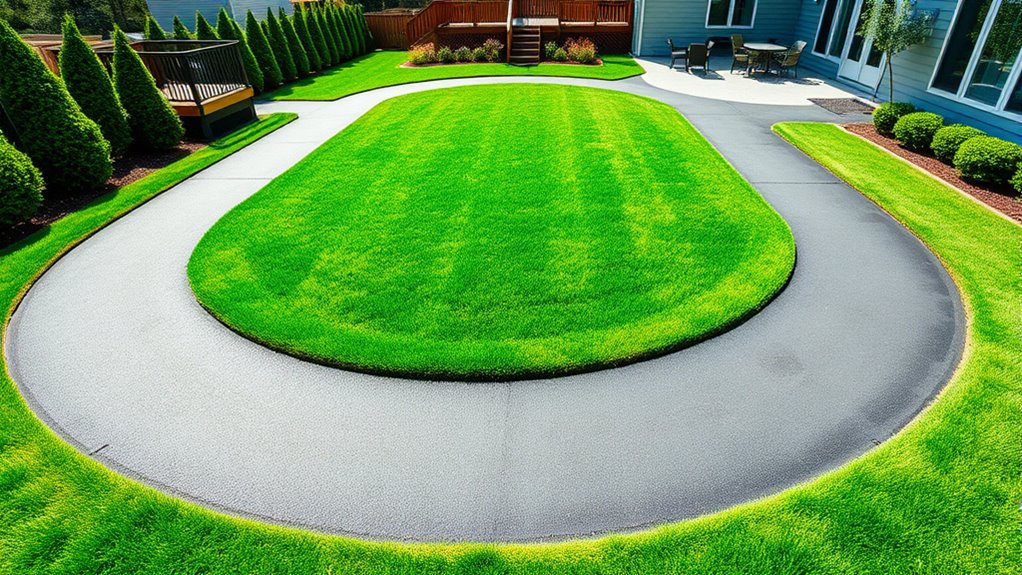
Adding a lap lane to your existing yard can be a rewarding project that enhances your outdoor space and fitness routine. When planning this addition, understanding the pool dimensions is essential. A standard lap pool typically measures between 25 to 50 feet in length and about 3 to 6 feet in width. These dimensions are designed to provide enough space for effective swimming workouts without overwhelming your yard. You’ll want to consider how much space you have and how large you want your pool to be, keeping in mind your home’s layout and landscaping. The size of the lap lane will influence your overall project costs and the amount of excavation and construction required. Additionally, you need to check local regulations regarding construction permits. Many jurisdictions require permits for in-ground pools, especially if they involve significant excavation or structural work. Securing the proper permits ensures your project complies with safety standards and avoids potential fines or issues during inspections. It’s a step you shouldn’t overlook, as failure to obtain permits can lead to costly delays or the need to dismantle parts of your pool.
Once you’ve determined the appropriate pool dimensions and secured necessary permits, you can start thinking about the construction process. Building a lap lane involves excavation, pouring a concrete or gunite shell, and installing plumbing and filtration systems. The complexity of these steps varies based on the size of your pool and existing yard conditions. For example, if your yard has good soil and minimal obstructions, construction might proceed more smoothly and cost-effectively. Conversely, rocky or uneven terrain could increase labor and material costs. You’ll also need to factor in the type of finish you prefer—tile, plaster, or aggregate—and the quality of materials used, all of which impact your overall budget. Additionally, considering the potential for market growth projected at over 40% CAGR in AI tech by 2025, integrating smart pool systems could enhance your swimming experience and maintenance efficiency.
Budgeting for a lap lane should include not only construction costs but also ongoing expenses like maintenance, chemicals, and energy for the filtration system. It’s wise to get multiple quotes from reputable contractors and ask about their familiarity with local permit requirements. This way, you ensure your project stays within budget and meets all legal standards. Remember, a well-planned lap lane isn’t just about adding a feature to your yard; it’s about creating a functional, safe, and enjoyable space that fits your lifestyle and property. With proper planning, you’ll enjoy many years of swimming and outdoor relaxation, all while avoiding costly surprises down the line.
Frequently Asked Questions
What Permits Are Required for Building a Lap Lane?
You’ll need to obtain local building permits before constructing a lap lane, guaranteeing you meet safety standards. These permits often require inspections for pool safety and water quality maintenance. Check with your city or county building department to understand specific requirements. Securing these permits helps ensure your pool complies with regulations, promoting safe swimming and proper water management. Always follow local codes to avoid penalties or future modifications.
How Long Does Installation Typically Take?
You’ll find installation usually takes around 2 to 4 weeks, depending on your yard’s size and complexity. During this time, you should plan for pool cleaning to keep the area safe and tidy. Installing safety barriers is also essential and can add a few extra days. Coordinating with professionals guarantees a smooth process, so you can enjoy your new lap lane sooner and with confidence in its safety features.
Can a Lap Lane Be Installed in Winter?
Yes, you can install a lap lane in winter, but it requires proper yard preparation and planning for winter installation. Cold weather can slow down construction, so guarantee the ground is adequately prepared and protected from freezing. Contractors might need to use special equipment or techniques to work efficiently during winter, so communicate your needs. With proper planning, you can enjoy your lap lane year-round, even in colder months.
What Maintenance Is Needed Afterward?
Think of your lap lane like a delicate garden — it needs regular care. You’ll want to check the landscaping considerations, like edging and drainage, to prevent weeds and water issues. Routine cleaning and inspecting for cracks or damage are essential for safety precautions. Regular chemical balancing and filter cleaning keep the water clear. With consistent maintenance, your lap lane stays safe, inviting, and ready for your next swim.
Are There Financing Options Available?
Yes, there are financing options and payment plans available to help you afford building a lap lane. You can explore options like personal loans, home improvement loans, or manufacturer financing programs. Many providers offer flexible payment plans that break down costs into manageable installments, making it easier to fund your project without a significant upfront payment. Be sure to compare terms and interest rates to find the best financing option for your budget.
Conclusion
Building a lap lane in your yard is a rewarding investment, turning your space into a personal oasis of health and relaxation. Like Da Vinci’s brushstrokes crafted masterpieces, your effort transforms your yard into a sanctuary of wellness. With careful planning and a bit of dedication, you’ll create a legacy of health, echoing the timeless pursuit of mastery. Start today, and watch your backyard become the stage for your triumphs—just as champions once began with a single step.
